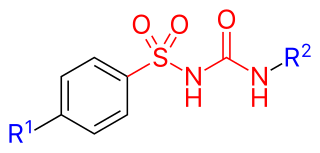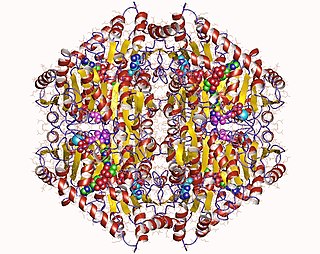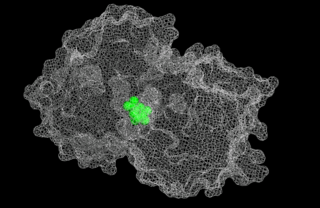
Herbicides, also commonly known as weed killers, are substances used to control undesired plants, also known as weeds. Selective herbicides control specific weed species while leaving the desired crop relatively unharmed, while non-selective herbicides (sometimes called total weed killers kill plants indiscriminately. Due to herbicide resistance – a major concern in agriculture – a number of products combine herbicides with different means of action. Integrated pest management may use herbicides alongside other pest control methods.

Sulfonylureas or sulphonylureas are a class of organic compounds used in medicine and agriculture. The functional group consists of a sulfonyl group (-S(=O)2) with its sulphur atom bonded to a nitrogen atom of a ureylene group (N,N-dehydrourea, a dehydrogenated derivative of urea). The side chains R1 and R2 distinguish various sulfonylureas. Sulfonylureas are the most widely used herbicide.

The acetolactate synthase (ALS) enzyme is a protein found in plants and micro-organisms. ALS catalyzes the first step in the synthesis of the branched-chain amino acids.
In enzymology, a 2-acetolactate mutase is an enzyme that catalyzes the chemical reaction
The enzyme acetolactate decarboxylase (EC 4.1.1.5) catalyzes the chemical reaction

The enzyme oxalyl-CoA decarboxylase (OXC) (EC 4.1.1.8), primarily produced by the gastrointestinal bacterium Oxalobacter formigenes, catalyzes the chemical reaction
In enzymology, a 2-isopropylmalate synthase (EC 2.3.3.13) is an enzyme that catalyzes the chemical reaction

Metsulfuron-methyl is an organic compound classified as a sulfonylurea herbicide, which kills broadleaf weeds and some annual grasses. It is a systemic compound with foliar and soil activity, that inhibits cell division in shoots and roots. It has residual activity in soils, allowing it to be used infrequently but requiring up to 22 months before planting certain crops. It has very low toxicity to mammals, birds, fish, and insects but is a moderate eye irritant.

α-Acetolactic acid is a precursor in the biosynthesis of the branched chain amino acids valine and leucine. α-Acetolactic acid is produced from two molecules of pyruvic acid by acetolactate synthase. α-Acetolactic acid can also be decarboxylated by alpha-acetolactate decarboxylase to produce acetoin. The name α-acetolactate is used for anion, salts, and esters of α-acetolactic acid.

Monocerin is a dihydroisocoumarin and a polyketide metabolite that originates from various fungal species. It has been shown to display antifungal, plant pathogenic, and insecticidal characteristics. Monocerin has been isolated from Dreschlera monoceras, D. ravenelii, Exserohilum turcicum, and Fusarium larvarum.

5-enolpyruvylshikimate-3-phosphate (EPSP) synthase is an enzyme produced by plants and microorganisms. EPSPS catalyzes the chemical reaction:

Imazaquin is an imidazolinone herbicide, so named because it contains an imidazolinone core. This organic compound is used to control a broad spectrum of weed species. It is a colorless or white solid, although commercial samples can appear brown or tan.

Monochoria korsakowii is a species of annual flowering plant in the water hyacinth family known by several common names, including heartleaf false pickerelweed and oval-leafed pondweed. It is found in lakes, ponds, swamps, and rice paddy fields.

Flazasulfuron is an organic compound that is used as a herbicide. It is classified as a sulfonylurea, because it contains that functional group. The mode of action of flazasulfuron is the inhibition of the enzyme acetolactate synthase (ALS), which results in the inhibition of amino acid synthesis, cell division and ultimately plant growth. Flazasulfuron can be used on both pre-emergent weeds and post-emergent weeds. Growth ceases within hours of the application of the compound. Symptoms include leaf discolouration, desiccation, necrosis and ultimately plant death within 20 – 25 days of application. It is a white, water-soluble solid.

Tribenuron in the form of tribenuron-methyl is a sulfonylurea herbicide. Its mode of action is the inhibition of acetolactate synthase, group 2 of the Herbicide Resistance Action Committee's classification scheme.

Chlorsulfuron is an ALS inhibitor herbicide, and is a sulfonylurea compound. It was discovered by George Levitt in February 1976 while working at DuPont, which was the patent assignee.

Halosulfuron-methyl is a sulfonylurea post-emergence herbicide used to control some annual and perennial broad-leaved weeds and sedges in a range of crops, established landscape woody ornamentals and turfgrass. It is marketed under several tradenames including Sedgehammer and Sandea.

Penoxsulam is sulfonamide and triazolopyrimidine herbicide that acts as an acetolactate synthase inhibitor. It is primarily used for rice production.















